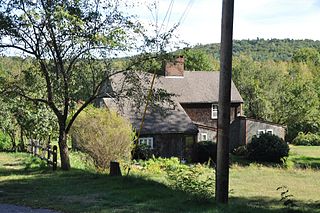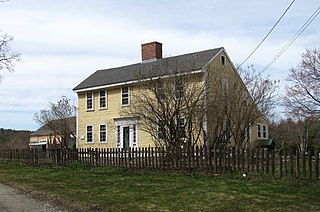
The Peter Woodbury House is a historic First Period house in Beverly, Massachusetts. It is a 2+1⁄2-story wood-frame structure, five bays wide, with a side-gable roof, large central chimney, and clapboard siding. Like most surviving First Period houses, this one was built in stages. The earliest part, dating to c. 1696, was the right front section and chimney. The left side was built in the 18th century, as was the rear leanto, which was later raised to a full second story.

The Dyke-Wheeler House is a historic colonial house in Gloucester, Massachusetts. The 2+1⁄2-story plank-framed First Period house was built in about 1720, and has a typical center chimney plan. The leanto section was added c. 1800. The house was at one time believed to have been built earlier, in the 1660s, by a man named Richard Dyke. The house was later owned by the Wheeler family for whom Wheeler's Point, where the house is located, is named. It is one of two First Period houses surviving on Wheeler's Point.

The Emerson House is a historic late First Period house in Haverhill, Massachusetts. The oldest part of this 2+1⁄2-story wood-frame house was built c. 1730, and contains construction features characteristic of the transition between First and Second Period methods. The first part built was the central chimney with the right front rooms, which were followed later by the left side rooms, and then a rear leanto section. The left side was probably built by Nehemiah Emerson, who bought the house in 1787. The house was originally located at the corner of Winter and Pecker Streets, and was moved to its present location in the 1850s. It still retains elements of original Federal period styling.

The Rea Putnam Fowler House is a historic house in Danvers, Massachusetts. It is a 2+1⁄2-story timber-frame structure, five bays wide with a side gable roof, clapboard siding, and a slender central chimney. A leanto section extends to the rear, giving the house a classic saltbox profile. The leanto section extends beyond one of the sides, creating what is called a "Beverly jog". The front entrance is centered, and is sheltered by a late 18th or early 19th-century porch. The oldest portion of the house, its western three bays and leanto, was built about 1700, and the eastern bays were added about 1725. The original chimney was quite large; the present chimney is a 19th-century replacement, and a second chimney in the leanto is a 20th-century addition. The house underwent a historically sensitive restoration in the 1930s, under the auspices of the Society for the Preservation of New England Antiquities.

The Hastings-Morse House is a historic First Period house in Haverhill, Massachusetts. The oldest portion of the 2+1⁄2-story wood-frame house, its central chimney and right-side rooms, were probably built c. 1706 by a man named Hastings. Left-side rooms and a partial leanto section on the back of the house were added during the 18th century. The house underwent a major restoration in the late 1957, which included raising the roof on the leanto section. Another 20th-century addition is the sunroom on the left (west) side of the house. Evidence of the building's First Period origins is still visible in the right front room.

The Stanley Lake House is a historic First Period house in Topsfield, Massachusetts. It is a 2+1⁄2-story wood-frame house that was built in stages by Mathew Stanley or his heirs between c. 1675 and 1693 and subsequently enlarged by the Lake family. It illustrates a host of building practices over the 17th and 18th centuries. The first Matthew Stanley house was said by Dow to be located northwest of this building. The first portion of this building is the section from the chimney westward. An easterly room was added after and a further addition to the east by the Lakes c. 1750. Matthew Stanley's heirs having removed to the Attleborough Falls area, sold the 70 acre farm property 1710- 1718 to Eleazer Lake. The property also includes a rare First Period barn. It was listed on the National Register of Historic Places in 1990. In 2005 it was named a contributing property to the River Road-Cross Street Historic District.

The House on Labor-in-Vain Road is a historic house in Ipswich, Massachusetts. Built about 1720 and enlarged c. 1810, it has a well-preserved assortment of architectural stylistic details predating 1850. It was listed on the National Register of Historic Places in 1990.

The Col. John Osgood House is a historic late First Period house in North Andover, Massachusetts. The original part of the house, its left side, was built c. 1720. A second, similar building was then attached to the right side of the chimney at a later date, demonstrating an unusual method of joining the two structures. The house was listed on the National Register of Historic Places in 1990.

The Moses Brewer House is a historic late First Period house located in Sudbury, Massachusetts.

The Brown–Stow House or Ichabod Stow House is a historic First Period house in Stow, Massachusetts. The oldest portion of this two-story timber-frame house was probably built early in the 18th century, and consisted of a single "cell" three bays wide, two stories high, with what is now the central chimney in a side bay. During the 18th century it was expanded twice, adding a second cell and a rear leanto. It has had two modest 20th century additions. The house underwent a major restoration in the 1950s to return it to an 18th-century appearance. The house was probably built by Boaz Brown, who acquired the property in 1699 and died in 1711.

The Isaac Bullard House is a historic late First Period house located in Holliston, Massachusetts.

The Walcott-Whitney House is a historic late First Period house in Stow, Massachusetts. It is a 2+1⁄2-story timber-frame house, five bays wide, with a side gable roof, clapboard siding, and a large central chimney. A leanto extends to the rear, giving it a saltbox profile. The front facade is asymmetrical, with a roughly centered entrance that has a Federal period surround of sidelights, pilasters, and entablature with cornice. The house was built c. 1720–30, and is a well-preserved example of the period. It is particularly noted for its well-preserved front staircase.

The Christopher Page House is a historic First Period house in Bedford, Massachusetts. The 2+1⁄2 story timber-frame house was built c. 1730, exhibiting construction techniques that are transitional between First Period and Georgian practice. The main block is five bays wide with a large central chimney, and an added leanto section. A leanto dormer was added in the late 19th century, as was the Colonial Revival front porch. The interior and exterior both received stylistic treatment during the Federal period.

The Joseph Damon House is a historic house in Reading, Massachusetts. Built about 1754, this 2+1⁄2-story wood-frame house is good local example of a Georgian colonial house with later Federal period alterations. It also demonstrates a typical pattern of shared ownership by multiple descendants of one of its owners. The house was listed on the National Register of Historic Places in 1984.

The Edward Oakes House is a historic house at 5 Sylvia Road in Medford, Massachusetts. It is a 2+1⁄2-story timber-frame house, five bays wide, with a gambrel roof, wood shingle siding, and a brick foundation. A rear leanto section gives the house a saltbox appearance. The main entrance is flanked by sidelight windows. It was built c. 1728, probably by Edward Oakes. It is one of the oldest surviving wood-frame houses in Medford, and is unusual for the period due to its gambrel roof.

The Bullen–Stratton–Cozzen House is a historic First Period house in Sherborn, Massachusetts. Its oldest portion is estimated to date to about 1680, and the building reflects changes in taste and use over the intervening centuries. The house was listed on the National Register of Historic Places in 1986.

The Richard Sanger III House is a historic house in Sherborn, Massachusetts. It is a 2+1⁄2-story timber-frame house, five bays wide, with a side gambrel roof and clapboard siding. The windows of the front facade are symmetrically placed, but the door is slightly off-center, flanked by sidelight windows and topped by a gabled pediment. The house was built c. 1734, with a rear leanto added around 1775. It is unusual in the town as an 18th-century gambrel-roofed house with leanto. Sanger was the son of a Boston merchant, and one of the few people on the town documented to own slaves.

The Thaddeus Jackson House is a historic house at 15 Alberta Road in Brookline, Massachusetts. Built in 1820, it is one of Brookline's older surviving houses, unusual because it was built in the Georgian style, then already out of fashion. The house was listed on the National Register of Historic Places on October 17, 1985.

The John Tyler House is a historic house at 242–250 East Main Street in Branford, Connecticut. Built about 1710, it is one of the town's few surviving 18th-century residences, and a good example of late First Period architecture. The house was listed on the National Register of Historic Places in 1988.

The Jonathon Keyes Sr. House, also known incorrectly in town histories as the Solomon Keyes House, is a historic house at 16 Frances Hill Road in Westford, Massachusetts. It was probably built in the mid-18th century, and is one of the town's oldest surviving buildings. It was listed on the National Register of Historic Places in 2019.























